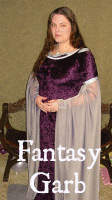My First Tudor gown by La Signora Onorata Katerina da Brescia.
to be removable, so I
could recycle the dress later for use as an
underdress or tourney dress.
I was happy with the look of the bodice, It looked comparably 'flat' with regards to the original portraits, seen on the left.
I used a red linen underskirt instead of a farthingale. Again, Tudor Tailor states that the farthingale was used later (Princess Elizabeth had one in her portraits) with the larger sleeves.
The narrower sleeves appear to be an earlier fashion, hence no farthingale.
I was happy with the look of the bodice, It looked comparably 'flat' with regards to the original portraits, seen on the left.
I used a red linen underskirt instead of a farthingale. Again, Tudor Tailor states that the farthingale was used later (Princess Elizabeth had one in her portraits) with the larger sleeves.
The narrower sleeves appear to be an earlier fashion, hence no farthingale.
The portraits have a form of French Hood. I wanted one that was both easy to wear. I found a really good proposal for the construction of a French Hood at Mode Historique.
First Layer.
  |
Firstly, a coif was made
of linen. I hemmed in the edges, turned over the top to form the coif
shape and whipstitched the edges. The trim was made from a metallic
ribbon which I cartridge pleated. (I was not sure it would heat pleat
without melting!) The cord channel was also hand sewn and a
hand-knitted cord added. |
 |
The back was made from
black cotton velveteen (it really pays not to throw out bits of
material!!) to the pattern on the left. (you can see where I planned on
adding the jewels). The velveteen veiling was flat lined with black 'gold satin' from yet another project. Millinry wire was used to give a rounded "U" shape to the front. This was the only wire used in this project. |
Putting
it together:
This makes the whole ensemble very stable. |
  |
Final outfit:
Left:
Inspiration. Right: my interpretation.


Conclusions and
Assumptions:
Assumptions:
The dress stiffening held up very well when at home... until I got into my car and put the seatbelt on.
Number 1 crunch!
Number 2 crunch: Poor modern posture added to my body type (really need to loose the middle).
This only 'folding' occurred below the bust. Otherwise the bust and stomach areas remained quite flat and still are! The buckram held up really well with the rainy day (I thought the moisture would be my biggest problems).
Assumptions:
- similar tailoring methods were used in 1540s' Italy as to 1540's England. (as to research available)
- stiffening used instead of corset (based on published research)
- use of linen is suitable substitution (due to cost and availability)
- theory for method of making French Hood
- Hem treatment not visible on portraits.
- Hair under hood is braided and taped
- Use of my Silk embriodered camicia was appropriate
- Trim on sleeve could be applied "on top" of the sleeve
- the waist was 'dipped' and not straight (it is difficult to see in either portrait)
- textile belt
The dress stiffening held up very well when at home... until I got into my car and put the seatbelt on.
Number 1 crunch!
Number 2 crunch: Poor modern posture added to my body type (really need to loose the middle).
This only 'folding' occurred below the bust. Otherwise the bust and stomach areas remained quite flat and still are! The buckram held up really well with the rainy day (I thought the moisture would be my biggest problems).
Bibliography:
- Ajmar-Wollheim, Marta & Dennis, Flora (ed). At Home in Renaissance Italy. V&A Publications London, 2006. ISBN: 10 1 85177 488 2.
- Brown, Pauline. The Encyclopedia of Embroidery Techniques. New Burlington Books, London. 2002. ISBN: 1-86155-652-7
- Currie, Elizabeth. Inside the Renaissance House. V&A Publications, London, 2006. 10 1 85177 490 6.
- Mikhaila, Ninya & Malcolm-Davies, Jane. The Tudor Tailor. BT Batsford.London. 2006. ISBN:0 7134 8985 5
- Tudor Research - www_kimiko1_com.htm (Portrait of a Woman)
- http://www.metmuseum.org/works_of_art/collection_database/european_paintings/
- Portrait_of_a_Young_Woman/viewObject.aspx?&OID=110001110&PgSz=1
- new tudor portratis http://www.marileecody.com
- Mode Historique: Fabulous French Hoods (Sarah Lorraine)http://modehistorique.com/elizabethan/french_hood/french_hoods.html (3/08)
- elizabethanportratis.com
- anne boleyn gallery http://tudorhistory.org/boleyn/anneboleyn2.jpg
- Archeological Sewing by Heather Rose Jones (2001)
- http://heatherrosejones.com/archaeologicalsewing/index.html (new adsottana: 8/06)
- Archive of Stitches from Extant Textiles. www.bayrose.org
- Sewing Stitches Used in Medieval Clothing: http://www.personal.utulsa.edu/~marc-carlson/cloth/stitches.htm
- HABERDASHERY FOR USE IN DRESS 1550-1800 by POLLY HAMILTON BA (Hons)
- http://wlv.openrepository.com/wlv/bitstream/2436/14406/2/Hamilton%20PhD%20thesis%202007.pdf
- http://modehistorique.com/elizabethan/french_hood/french_hoods.html#construction
(c)
June, 2008



All intellectual content, photos and layout are copyright to La Signora Onorata Katerina da Brescia (K Carlisle), except those original renaissance artworks and extant articles whose copyright remains with the current owner.









